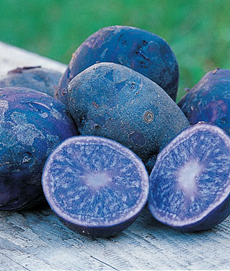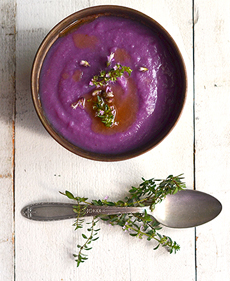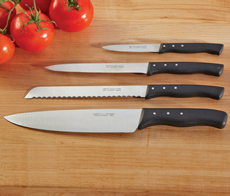|
We’re cooking up some food fun for tomorrow, April Fool’s Day. This year, it’s trompe-l’oeil food.
Trompe-l’oeil (pronounced trump LOY), French for “deceive the eye”, is an art technique that creates the optical illusion that a piece of two-dimensional art exists in three dimensions.
You may have seen some amazing sidewalk art that fools you into thinking you’re about to step into a hole, a pool, etc.
Here’s one of our favorite trompe l’oeil paintings, of a boy “climbing out of” the picture frame.
We’re adapting the “deceive the eye” reference to “food trompe-l’oeil”—food that looks like one thing but is actually another. Serve this “grilled cheese and tomato soup” dish, which is actually orange pound cake and strawberry soup.
Thanks to Zulka Morena sugar for the recipes and fun idea. If you’ve got a great palate or simply prefer less processed sugar, try it. The top-quality sugar is minimally processed and never refined. You can taste the difference!
RECIPE #1: ORANGE POUND CAKE
Ingredients
For The Pound Cake
1 cup unsalted butter, room temperature
1-1/4 cups sugar
2 tablespoons orange zest
5 large eggs, lightly beaten
2-3/4 cups all-purpose flour
1/4 teaspoon baking soda
1/4 teaspoon sea salt
8 ounces sour cream
2 tablespoons orange juice
For the Frosting
1/2 cup butter
2 cups powdered sugar
1 teaspoon orange extract or juice
2-5 drops natural orange food color
Preparation
1. PREHEAT oven to 325°F. Butter and flour a standard loaf pan.
2. CREAM together in a medium bowl the butter, sugar, and orange zest until fluffy. Add the eggs in 3 parts, combining well after each addition. In a separate small bowl…
3. COMBINE the flour, baking soda, and salt. Add flour mixture to butter mixture until just combined. Add the sour cream and orange juice and mix well.
4. POUR into the prepared loaf pan, smoothing the top, and bake for 1 hour or longer, until a toothpick placed in the center comes out clean. If the top starts to brown too much before the cake is done, tent it with a piece of foil.
5. REMOVE from oven; cool in pan for 10 minutes then remove to wire rack to cool completely.
6. MIX the frosting ingredients together until well combined. Add more food color as needed to reach the desired color.
7. ASSEMBLE: Slice the pound cake into 1/2 inch slices. Spread a small amount of butter on one side and grill on a griddle or skillet until toasted looking, being careful not to burn. Let cool completely. Repeat with remaining slices. Once all are cool…
8. CUT them each in half to make the two halves of each “sandwich.” Spread about a tablespoon of frosting on a non-toasted side of the cake, spreading some to the edges to make it look like melted cheese, and then top with the other half. Repeat with the emaining slices.
RECIPE #2: CHILLED STRAWBERRY SOUP
Ingredients For 6 Servings
2 pounds strawberries, stems removed and hulled
2/3 cup sugar
1/2 cup orange juice
1/2 cup cranberry juice
1-1/2 cups plain or vanilla yogurt
Optional: yellow food color
Optional garnishes: 1-2 tablespoons heavy cream, fresh basil leaves
Preparation
1. DICE the strawberries, sprinkle the sugar over the top, and let sit for 15 minutes. Combine all the ingredients in a blender and purée until smooth. Let chill completely. If you want the color to be more orange, like tomato soup, add a few drops of yellow food color.
2. DIVIDE among 6 bowls. Drizzle a little heavy cream over the top and garnish with basil leaves.
|
|
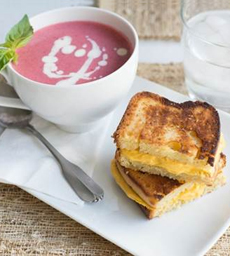
[1] April Fool’s food: Standing in for tomato soup and a grilled cheese sandwich are strawberry soup and pound cake (photo © Zulka Sugar).

[2] Orange zest and juice create a delicious orange pound cake (photo © Eva Elijas | Pexels).
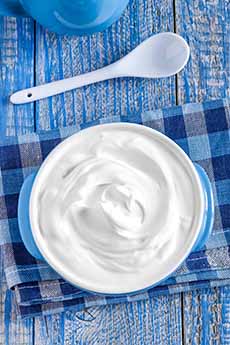
[3] Sour cream adds richness (photo © Yelena Yemchuk | Panther Media).

[4] Zulka makes less processed, better tasting sugar. (photo © Zulka Sugar).
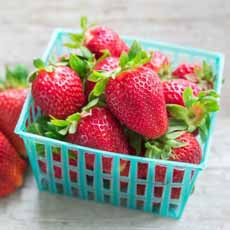
[5] Turn fresh strawberries into delicious strawberry soup (photo © Good Eggs).
|
APRIL FOOL’S DAY HISTORY
The origin of April Fools’ Day, sometimes called All Fools’ Day, is obscure. The most accepted explanation traces it to 16th century France.
Until 1564, the Julian calendar, which observed the beginning of the New Year in April, was in use. According to The Oxford Companion to the Year, King Charles IX then declared that France would begin using the Gregorian calendar, which shifted New Year’s Day to January 1st.
Some people continued to use the Julian Calendar, and were mocked as fools. They were invited to bogus parties, sent on a fool’s errand (looking for things that don’t exist), and other pranks.
The French call April 1st Poisson d’Avril, or April Fish. French children sometimes tape a picture of a fish on the back of their schoolmates, crying “Poisson d’Avril” when the prank is discovered.
What a fish has to do with April Fool’s Day is not clear. But in the name of a kinder, gentler world, we propose eliminating this holiday. (Source: Wikipedia)
CHECK OUT WHAT’S HAPPENING ON OUR HOME PAGE, THENIBBLE.COM.
|
